Northern Shrike
- December 5, 2023
- 0 comment
The Northern Shrike(Lanius borealis) belongs to the family Laniidae, The genus name “Lanius” is derived from the Latin word for “butcher,” alluding to the bird’s habit of impaling its prey on thorns or barbed wire. The species name “borealis” means “northern,” indicating its distribution in the northern hemisphere.
Physical Appearance
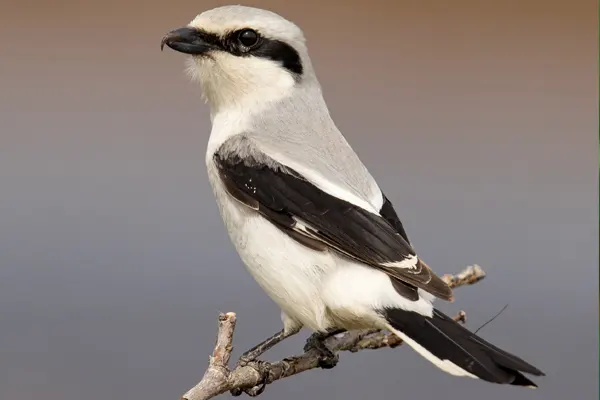
Northern Shrike
- Lifespan: 6-11 years
- Habitat: Mixed Forests, Open Woodlands, Shrublands, and Agricultural areas.
- Diet: Small Mammals, mice, voles, shrews and Also eats small birds, insects, and reptiles
- Size: 22-26 cm
- Weight: 60-100 grams
- Wingspan: 32-40 cm
- Conservation Status: Least Concern.
- Population Trend: Stable.
The Northern Shrike is a medium-sized songbird with a distinctively bold appearance. They are about 9 inches in length and have a wingspan of up to 14 inches. Their plumage is primarily pale gray with a black mask that extends from the forehead to the ear coverts. They also have black wings with a small white patch at the base of the primaries and a black tail with white outer feathers. Their underparts are pale gray with faint, fine barring.
Species Type
Northern Shrikes have a stout, hooked bill that is black. They also have a prominent tooth-like spike on either side of the upper bill and a corresponding notch on either side of the lower mandible. These features are thought to be adaptations for capturing and killing prey.
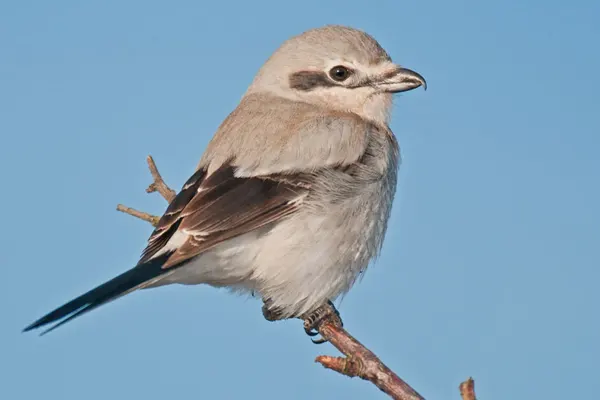
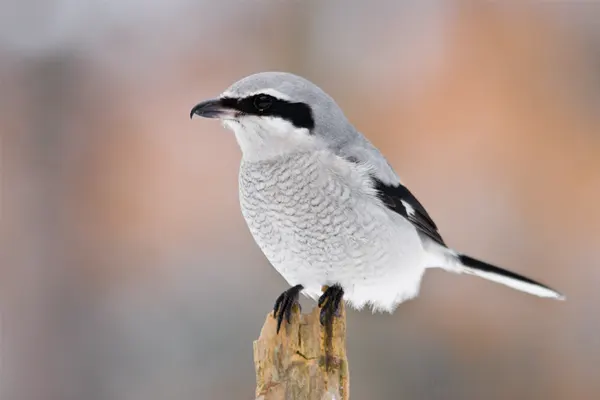
Northern Shrikes are often described as having a “fierce” or “aggressive” appearance. This is due to their bold black mask, hooked bill, and predatory behavior. They are known to be fearless hunters and will take prey that is much larger than themselves, such as mice, voles, and small birds.
Feather Coloration
The Northern Shrike’s plumage coloration serves several purposes. Its gray coloration provides camouflage in its forest habitat. The black mask and white patch on the wings are thought to be used for communication and signaling to other shrikes. The white outer tail feathers are also thought to be used for signaling during courtship and territorial displays.
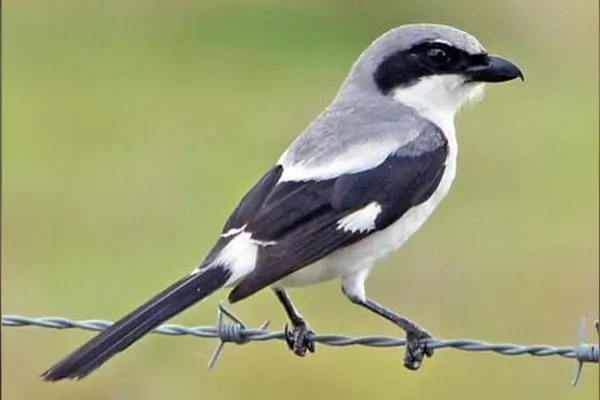
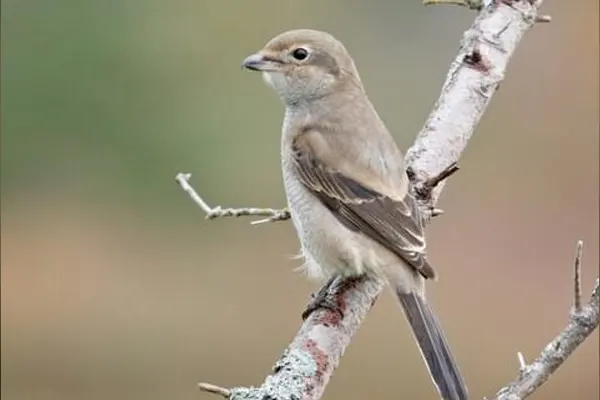
- Upperparts: Crown, nape, back, and upper rump: Pale to light neutral gray, with the tips of the scapulars whitish.
- Tail: Blackish, with moderately graduated rectrices and increasingly broad white tips from the center laterally.
- Upperwing: Primarily blackish to black, except for marginal lesser and alula coverts mostly gray.
- Throat: White
- Breast and belly: Pale gray with faint, fine gray barring
- Black mask: Extends from the forehead to the ear cover, but does not go across the top of the bill.
- White patch: At the base of the primaries on the wings
- White outer feathers: On the tail
Flight Characteristics
The Northern Shrike has a direct, powerful flight style, characterized by strong wingbeats and rapid bursts of acceleration. They are capable of both agile maneuvering and sustained flight, making them effective predators in both open and cluttered environments. Their flight characteristics are well-suited to their hunting strategies, which often involve chasing down prey or ambushing it from hidden perches.
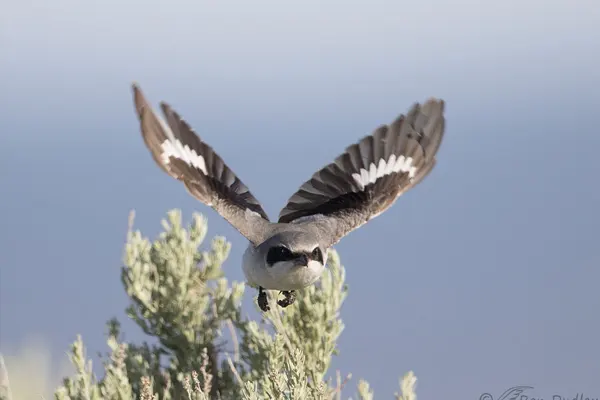
- Direct flight path: Northern Shrikes typically fly in a straight line, with minimal turning or gliding. This direct flight style allows them to quickly pursue prey or cover long distances during migration.
- Strong wingbeats: Northern Shrikes have powerful wings that generate a lot of thrust, enabling them to accelerate rapidly and maneuver quickly through dense foliage.
- Agile maneuvering: Northern Shrikes are capable of sudden changes in direction and speed, allowing them to catch elusive prey or avoid predators.
- Sustained flight: Northern Shrikes can maintain flight for long periods, enabling them to patrol large territories and cover long distances during migration.
- Hovering: Northern Shrikes are also capable of hovering briefly, allowing them to closely observe prey or maintain a position while preparing to strike.
Migration Patterns
The Northern Shrike is a migratory songbird that breeds in the far northern regions of North America and winters in Asia. They are considered medium- to long-distance migrants, typically traveling thousands of miles each year.
- Breeding Range: Northern shrikes breed in boreal forests and taiga across Canada and Alaska, as well as in the northernmost parts of the United States.
- Wintering Range: Their wintering range extends from eastern Siberia and northern China southward to Myanmar and northern India.
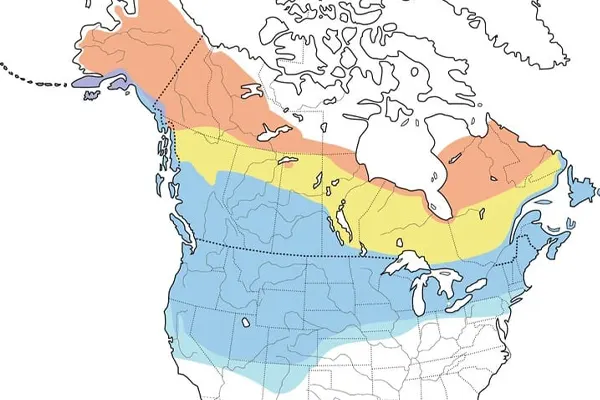
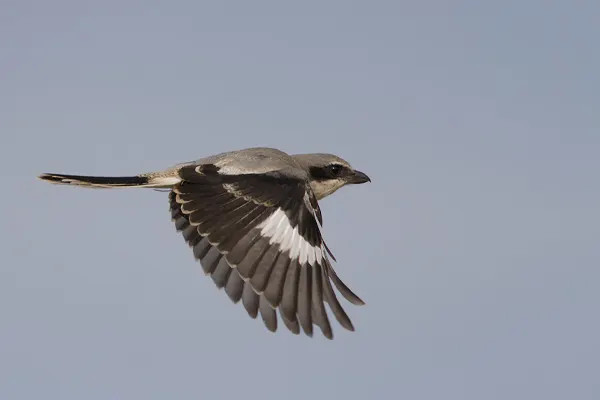
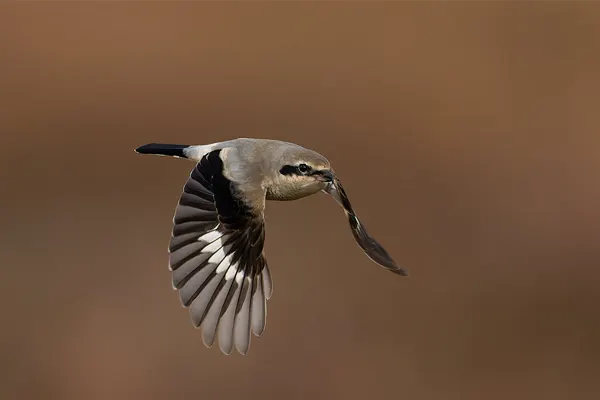
Migration Timing:
- Northern shrikes typically begin their fall migration in September and October.
- They arrive on their wintering grounds in Asia between November and December.
- The spring migration back to their breeding grounds begins in March and April.
- They typically arrive back in their breeding range by May and June.
Migration Routes:
- Northern shrikes typically migrate along a northwest-southeast axis, crossing the Bering Strait between Alaska and Siberia.
- Some individuals may take more circuitous routes, traveling through the Aleutian Islands or down the Kamchatka Peninsula.
Migration Factors:
- The timing and routes of northern shrike migration are influenced by several factors, including food availability, weather conditions, and day length.
- During migration, northern shrikes rely on a variety of food sources, including insects, small mammals, and birds.
- Favorable weather conditions, such as tailwinds and warm temperatures, can help them to travel more efficiently.
- Day length also plays a role in migration, as it helps to regulate their hormonal cycles and behaviors associated with migration.
Habitat & Distribution
Northern Shrikes are native to North America and Eurasia and are found in a variety of habitats, including boreal forests, taiga, and tundra. They are also found in open areas such as clearings, meadows, and agricultural land. This bird prefers habitats with a mix of open and closed areas, as this provides them with both food and cover. They are also found in areas with a variety of perches, such as trees, shrubs, and utility lines.
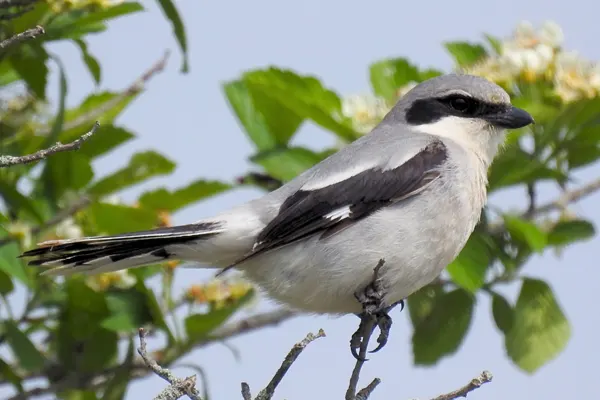

- Boreal forests: Thickly forested areas with coniferous trees such as spruce, fir, and pine
- Taiga: The transition zone between boreal forests and the tundra.
- Tundra: Treeless plains with a permafrost layer.
Behavioral Traits
These behavioral traits make the Northern Shrike a remarkable and captivating species, demonstrating their predatory prowess, adaptability, and unique communication strategies. They play an important role in the ecosystems they inhabit and serve as a reminder of the intricate balance of nature.
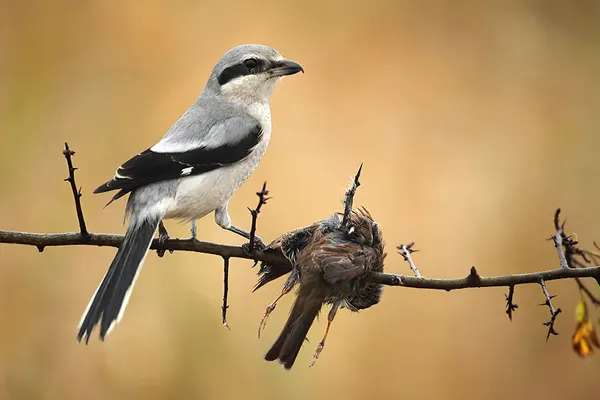
- Predatory Behavior: Northern Shrikes are fierce predators, known for their aggressive hunting techniques and ability to capture prey much larger than themselves. They primarily feed on small mammals, such as mice, voles, and shrews, but also consume birds, insects, and reptiles. Their hooked bills and sharp talons are well-adapted for catching and killing prey.
- Caching Behavior: Northern Shrikes are renowned for their habit of caching or impaling their prey on thorns, barbed wire fences, or other sharp objects. This behavior serves several purposes, including storing food for later consumption, attracting mates, and marking their territories.
- Aggressive Defense: Northern Shrikes are fiercely territorial and will aggressively defend their territories against intruders, including other shrikes, predators, and even humans. Their bold black mask is thought to play a role in territorial displays and intimidating rivals.
- Mimicry Behavior: Northern Shrikes are known to mimic the songs of other birds, possibly to attract prey or deceive other species. Their repertoire includes imitations of various songbirds, such as warblers, thrushes, and sparrows.
Role in Ecosystem
The Northern Shrike is an integral component of its northern ecosystems, playing a vital role in regulating prey populations, dispersing seeds, and contributing to nutrient cycling. Their presence serves as a testament to the interconnectedness of life and the importance of maintaining healthy and balanced ecosystems.
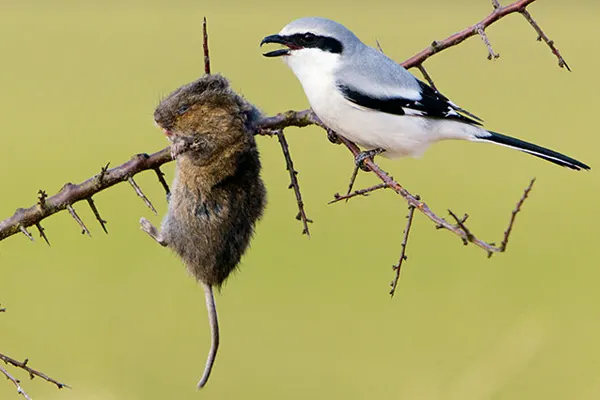
- Predator-Prey Dynamics: Northern Shrikes are apex predators in their northern boreal and taiga habitats, preying on a variety of small mammals, including mice, voles, shrews, and rodents. Their presence helps to control these populations, preventing them from reaching unsustainable numbers and causing damage to vegetation and ecosystems.
- Seed Dispersal: Northern Shrikes occasionally consume fruits and berries, and the seeds that pass through their digestive systems are often viable and can germinate. This contributes to plant reproduction and the regeneration of forests and other habitats.
- Nutrient Cycling: Northern Shrikes, like other predators, play a role in nutrient cycling by transferring nutrients from lower trophic levels (prey) to higher trophic levels (themselves). Their carcasses and waste products provide nutrients for decomposers and other organisms, contributing to the overall health of the ecosystem.
- Indicator Species: Northern Shrikes are sensitive to changes in their environment, and their presence or absence can serve as an indicator of the overall health of an ecosystem. Declines in their populations may signal environmental disturbances or imbalances in predator-prey dynamics.
- Ecological Balance: Northern Shrikes, as part of the intricate web of life, contribute to the overall balance and stability of ecosystems. Their presence helps to maintain healthy populations of prey species, promotes seed dispersal, and contributes to nutrient cycling.
Dietary Habits
The Northern Shrike is a carnivorous bird that primarily feeds on small mammals, such as mice, voles, and shrews. They are also known to eat birds, insects, and reptiles.
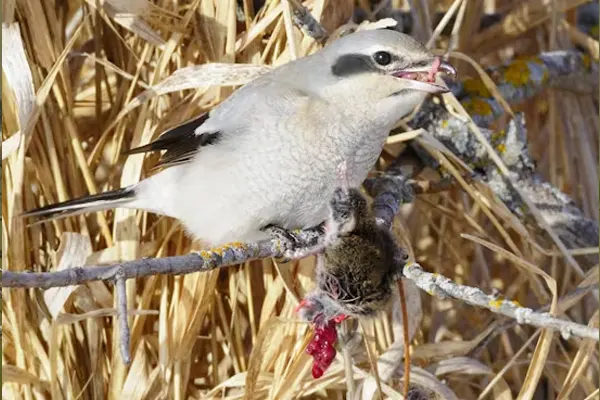

- Small mammals: Northern Shrikes are well-adapted for hunting small mammals, with their hooked bills and sharp talons. They often use perches to ambush their prey, and they have also been known to chase down prey on the ground.
- Birds: Northern Shrikes are opportunistic predators and will take a variety of bird species, including songbirds, sparrows, and even small raptors. They typically capture their avian prey in mid-air or from perches.
- Insects: Insects are a particularly important food source for Northern Shrikes during the summer months. They will eat a variety of insects, including beetles, caterpillars, grasshoppers, and flies.
- Reptiles: Northern Shrikes will occasionally eat reptiles, such as lizards and snakes. These prey items are typically found on the ground or in low vegetation.
Interesting Facts
- Also known as the “butcher bird” due to their habit of impaling their prey on thorns or barbed wire.
- Fearless predators known to take prey much larger than themselves, such as mice, voles, shrews, and even small raptors.
- Migrate over long distances between their breeding grounds in North America and their wintering grounds in Asia, traveling thousands of miles each year.
- Possess a unique tooth-like projection on their upper bill, thought to aid in grasping and killing prey.
- Exhibit aggressive territorial behavior, fiercely defending their territories against intruders, including other shrikes and predators.

- Practice caching behavior to store food for later consumption, attract mates, and mark their territories.
- Communicate through a variety of vocalizations, including harsh alarm calls, soft chattering sounds, and melodious whistles.
- Mimic the songs of other birds, possibly to attract prey or deceive other species.
- Considered intelligent birds, demonstrating problem-solving abilities in accessing cached prey and avoiding traps.
- Play an important role in their ecosystems as predators, helping to regulate populations of small mammals and other prey.
Nesting Habits
Northern shrikes are migratory songbirds that breed in the boreal forests and taiga of North America, primarily in Canada and Alaska. They typically nest in coniferous trees, such as spruce and fir, at heights ranging from 2.5 to 4 feet above the ground.
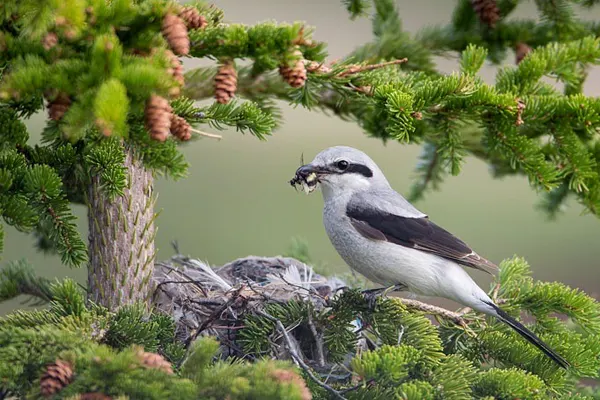
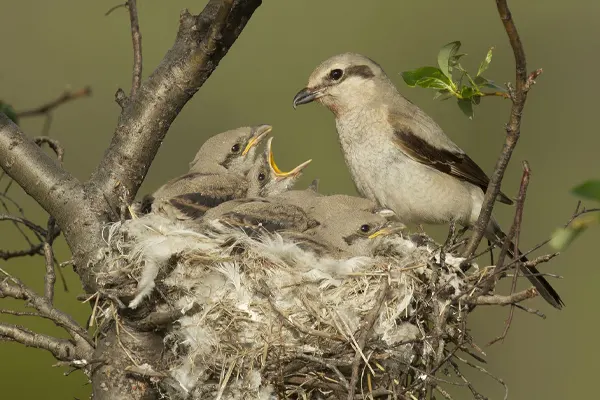
- Nest Construction: Nest building is a collaborative effort between the male and female Northern Shrike. The pair typically begins constructing the nest in May, and the process can take up to two weeks. The nest is a loosely constructed, bulky cup made of twigs, grass, bark strips, moss, and feathers. The female is responsible for most of the nest building, while the male assists in gathering materials.
- Nest Placement: Northern shrikes typically nest in forked branches near the trunk of a coniferous tree. They prefer nesting sites that are sheltered from the wind and rain, and they often choose trees that are located near the edge of a forest or clearing.
- Nest Size: Northern shrike nests are typically 4-6 inches in diameter and 3-4 inches deep. The inner cup of the nest is lined with feathers, hair, and soft plant fibers to provide insulation and comfort for the incubating female and hatchlings.
- Egg-Laying and Incubation: The female Northern Shrike lays a clutch of 3-9 eggs, which are typically pale blue or green with brown speckles. The incubation period is 13-14 days, and the female is responsible for incubating the eggs.
- Nestling Care: Both parents care for the nestlings, providing them with food and protection. The nestlings are altricial, meaning they are born helpless and require parental care for several weeks. They fledge, or leave the nest, at about 20-25 days old.
Melodious Song & Vocalizations
The Northern Shrike has a variety of vocalizations, which play an important role in communication and territorial defense.
- Alarm calls: Northern Shrikes have a loud, harsh “ack” call that they use to warn other individuals of danger. This call is typically given in response to the presence of predators or intruders.
- Chattering sounds: Northern Shrikes also make a variety of soft chattering sounds, which they use to maintain contact with their mates and offspring. These sounds are also thought to be used during courtship and food begging.

- Whistles: Northern Shrikes have a variety of melodious whistles, which they use to attract mates and defend their territories. Their whistles are often complex and varied, and they may mimic the songs of other birds.
- Vocalizations during nesting: During the nesting season, Northern Shrikes become more vocal, making a variety of calls to communicate with their mates and offspring. The female Northern Shrike also makes a soft “waik” call to attract her mate and beg for food.
- Individual variation: Northern Shrikes have a wide range of vocalizations, and individual birds may vary considerably in their calls and songs. This variation may be used for individual recognition and territory defense.
- Purpose of vocalizations: The vocalizations of the Northern Shrike serve a variety of important functions, including communication, territorial defense, courtship, and parental care. Their vocalizations are an essential part of their social and reproductive behavior.
Ecological Significance
Northern Shrikes play an important ecological role as predators in boreal forest ecosystems. They help to regulate populations of small mammals, birds, and insects, which can have a cascading effect on other members of the ecosystem.
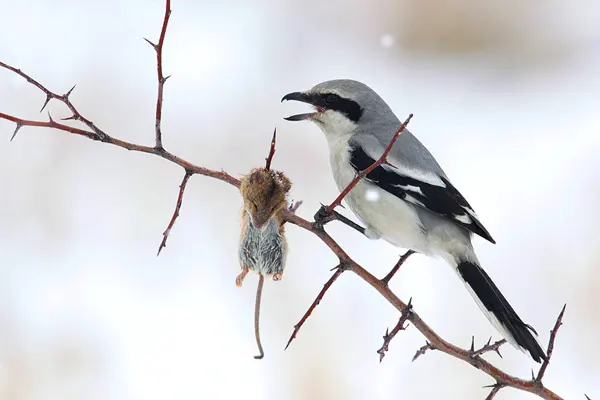
| Prey Item | Diet Proportion |
|---|---|
| Small mammals | 65% |
| Birds | 20% |
| Insects | 10% |
| Reptiles | 5% |
- Control of rodent populations: Northern Shrikes are one of the most effective predators of small mammals in boreal forests. They can help to reduce populations of rodents, such as voles and mice, which can damage trees and vegetation, and compete with other animals for food and resources.
- Suppression of insect outbreaks: Northern Shrikes prey on a variety of insects, including beetles, moths, and grasshoppers. These insects can damage crops and forests, and they can also spread diseases. By preying on these insects, Northern Shrikes can help to suppress outbreaks and protect the health of the forest.
- Seed dispersal: Northern Shrikes sometimes cache their prey, impaling it on thorns or barbed wire. This can help to disperse seeds, as the seeds from the prey’s stomach may germinate in the new location.
Conservation Status
The Northern Shrike is currently classified as Least Concern. This means that the species is not currently facing a high risk of extinction. However, Northern Shrike populations are declining in some areas due to a variety of threats.
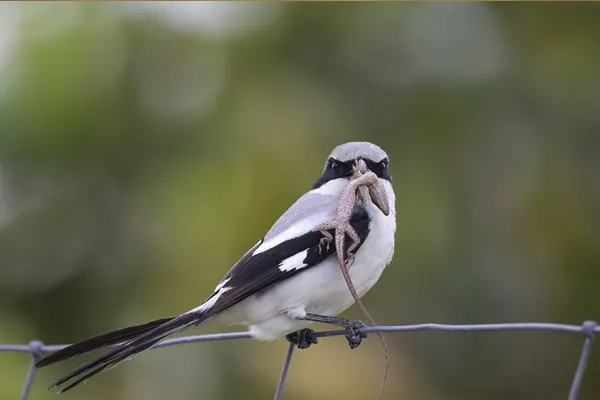
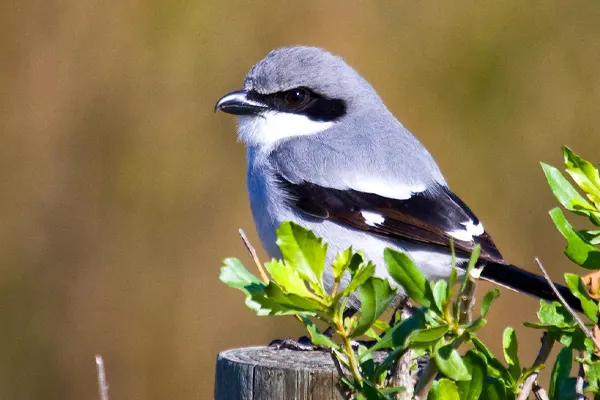
Habitat loss: Northern Shrikes are losing habitat due to deforestation, development, and climate change.
Climate change: Climate change is causing changes in the distribution and abundance of their prey.
Pesticides: Pesticides can harm Northern Shrikes and their prey.
The Northern Shrike is a fascinating and important bird species. With continued conservation efforts, we can help to ensure that this species continues to thrive in boreal forests around the world.
Research and Ongoing Studies
These ongoing research efforts provide valuable insights into the ecology, behavior, and conservation needs of the Northern Shrike, contributing to the development of informed management plans and conservation actions to ensure the long-term persistence of this remarkable species.
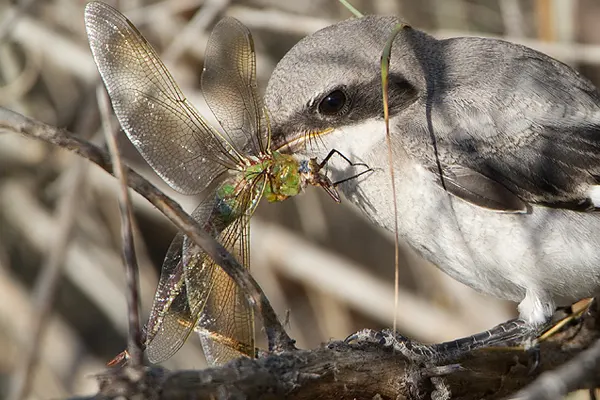
- Community Ecology and Interactions: Understanding the role of Northern Shrikes in the boreal forest ecosystem, including predator-prey dynamics, competition with other species, and contributions to nutrient cycling.
- Conservation Genetics and Population Genetics: Analyzing genetic diversity and connectivity among Northern Shrike populations to identify potential conservation units and management priorities.
- Population Dynamics and Trends: Monitoring population sizes and trends across different geographic regions to assess the overall status of Northern Shrike populations.
- Habitat Use and Selection: Understanding habitat preferences and requirements for breeding, wintering, and migration stages of the Northern Shrike’s life cycle.
Educational and Ecotourism
The Northern Shrike, with its striking appearance, diverse behaviors, and ecological significance, offers a wealth of educational and ecotourism opportunities to engage the public, promote conservation awareness, and foster a deeper appreciation for the natural world.
- School Programs: Incorporate the Northern Shrike into school curricula, engaging students in hands-on activities, interactive lessons, and discussions about its unique adaptations, predatory behavior, and ecological role.
- Public Lectures and Presentations: Organize public lectures and presentations by experts on Northern Shrike biology, conservation, and ecotourism, reaching a wider audience and raising awareness about the species.
- Interpretive Signage and Displays: Develop interpretive signage and displays at parks, nature reserves, and birding hotspots to provide visitors with information about the Northern Shrike’s natural history, habitat preferences, and conservation status.
- Citizen Science Projects: Engage the public in citizen science projects, such as monitoring Northern Shrike populations, documenting their vocalizations, or collecting data on their habitat use.
- Online Resources and Educational Materials: Create engaging online resources, such as interactive websites, educational videos, and downloadable activities, to provide accessible learning opportunities about the Northern Shrike.
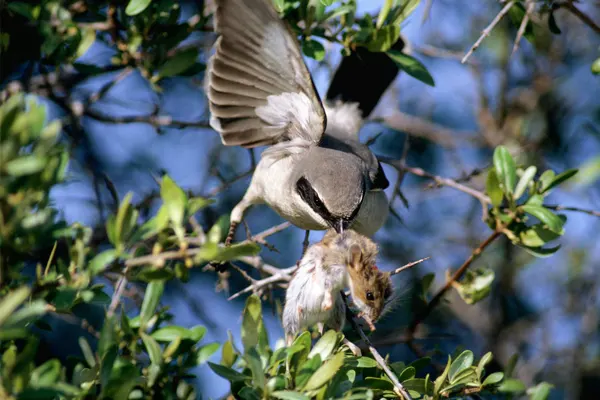
Ecotourism Opportunities:
- Birding Tours and Expeditions: Organize guided birding tours and expeditions to areas with high densities of Northern Shrikes, allowing participants to observe and learn about the species in its natural habitat.
- Wildlife Photography Workshops: Offer wildlife photography workshops focused on capturing the Northern Shrike’s diverse behaviors and interactions in its natural environment.
- Nature Camps and Immersive Experiences: Develop nature camps and immersive experiences that incorporate Northern Shrike-themed activities, such as birdwatching, habitat exploration, and discussions with experts.
- Ecotourism Packages and Tours: Create ecotourism packages and tours that highlight the Northern Shrike as a key attraction, encouraging sustainable travel and promoting conservation awareness.
- Partnerships with Local Communities: Collaborate with local communities to develop ecotourism initiatives that benefit the local economy while promoting responsible wildlife viewing practices.
Conclusion
The Northern Shrike, with its unique adaptations, diverse behaviors, and ecological significance, is a fascinating and remarkable bird species that holds a special place in the boreal forests of North America and Eurasia. Its striking appearance, fierce predatory nature, and habit of impaling prey on thorns have earned it the nickname “butcher bird”.
The Northern Shrike plays an important ecological role in regulating populations of small mammals, birds, and insects, contributing to the health and stability of boreal forest ecosystems. Its migratory behavior, traveling thousands of miles between breeding and wintering grounds, further highlights its adaptability and resilience.
Despite the challenges posed by habitat loss, climate change, and pesticides, Northern Shrike populations are currently considered to be of Least Concern. However, ongoing research and conservation efforts are crucial to monitor population trends, address threats, and ensure the long-term persistence of this remarkable species.
By leveraging educational and ecotourism opportunities, we can raise public awareness, promote conservation stewardship, and foster a deeper appreciation for the Northern Shrike and its invaluable contributions to boreal forest ecosystems. Through our collective efforts, we can safeguard this unique and charismatic bird species for generations to come.


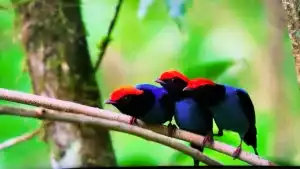



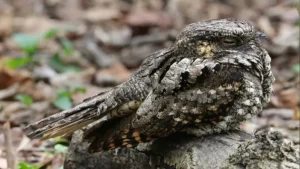

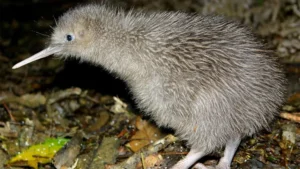
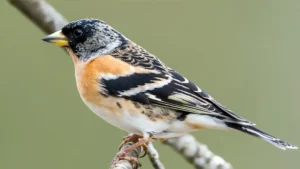



Leave your comment